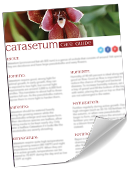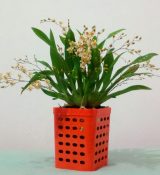Orchid Plant Insects Overview
Author: Celeste Booth2 Comments

Orchid Plant Family Insects Information Overview
Orchids are susceptible to a number of insects, bugs and mites, including aphids, mealybugs, scales, twospotted spider mites, and thrips. Aphids, mealybugs, and soft scales use their mouthparts to suck sap from orchid plants. They can curl, yellow, or stunt growth of leaves and can reduce flower production and stem growth. Insects like the ones mentioned above also excrete a clear, sticky liquid called honeydew. Black moldy fungus can grow on honeydew, covering leaves and making them unsightly.
Common Orchid Plant Insects
- Aphids – Such as the melon aphid (Aphisgossypii) are small, pear-shaped, soft-bodied insects with two tubelike projections called tail pipes sticking out from their abdomens. Aphids tend to cluster in groups. They feed on young growth, flower spikes, and developing flower buds. Aphids can cause orchids to become mottled and distorted. They are attracted to the fluid excreted by some orchids when they flower, and they are highly attracted to Cymbidiums.
- Mealybugs – The common mealybug species found attacking orchids are the citrus mealybug (Planococcus citri) and the longtailed mealybug, which are susceptible to Phalaenopsis and Dendrobiums roots. Mealybugs also feed on orchid sheaths and old leaves.
- Scales – Scales can be divided into two groups, soft and hard scales. Hard scales include the Boisduval scale (Diaspis boisduvalii) and Florida red scale, (Chrysom-phalus aonidum). Soft scales include Brown soft scale (Coccus hesperidum). One difference between these two groups is that soft scales produce honeydew and hard scales do not. A dome-shaped shell often covers later stages of hard scale. Orchids are attacked by many other different species of scales as well. Scales are small, round insects from about 1 to 5 mm long. They are most often found feeding on the underside of leaves along the midrib and underneath leaf sheaths. Cattleyas are highly susceptible to scales, especially the Boisduval scale. Many orchids are commonly attacked by a variety of different scale species.
- Mites – Twospotted spider mite (Tetranychus urticae) feeds on leaf undersides and sucks the chlorophyll out of plant cells. The feeding causes leaves to appear pin-poked, with yellow dots that give a characteristic silvery stippled appearance. Later, leaves turn yellow and sometimes fall off. Twospotted spider mites are greenish yellow, wingless, eight-legged creatures with a dark spot on each side of their body. They thrive when orchid plants are stressed under warm, dry conditions, but they are less of a problem under conditions of high humidity. Twospotted spider mites are found on new growth and on thin-leafed orchids. For early detection, tap leaves over a white sheet of paper and look for crawling twospotted spider mites. Cymbidiums are highly susceptible to mites.
- Thrips – Many thrips species feed on orchids, including western flower thrips (Frankliniella occidentalis), Cuban laurel thrips (Gynaikothrips ficorum), greenhouse thrips (Heliothrips haemorrhoidalis) and flower thrips (Frankliniella bispinosa). Thrips normally feed in flower buds and open orchid flowers. As a result, flowers may be deformed or fail to open. Eventually, flowers turn brown, and petals become streaked or silvery in appearance and discolored. Thrips are about 0.5 to 4.0 mm long and they are difficult to see with the naked eye. A hand lens is helpful in identifying these insects on orchid plants. Thrips feed by using their mouthparts like a straw to suck up orchid juices. For early thrips detection, gently blow into an open flower and watch for thrips crawling inside the blossom.
Orchid Insect Management
To minimize orchid insect problems, implement such cultural management strategies as prevention, sanitation, and plant inspection. Prevention is the best strategy for managing orchid insects. Proper cultural conditions, such as the correct amount of water, temperature, light, fertility, and humidity, minimize potential incest problems. Many reference books and manuals on orchid culture are available. Be sure to know the cultural practices of specific orchid plants being grown.
- Sanitation is a good strategy to prevent orchid insect problems. Remove all plant debris and old orchid medium. Also, remove old leaf sheaths to eliminate hiding places for mealybugs and scales. Inspect orchids on a regular basis by looking underneath leaves to detect the presence of aphids and spider mites. If pests are present, use a hard stream of water to dislodge insects and mites.
- Insecticides and miticides are another option when dealing with orchid insects, especially when populations are high. Insecticides such as insecticidal soap, malathion, acephate (Orthene), diazinon (Knox Out), chlorpyrifos (Dursban), and bendiocarb (Turcam/Dycarb) control aphids, mealybugs, scales, and thrips. Thrips are also controlled with spinosad (Conserve) and methiocarb (Mesurol). Twospotted spider mite is controlled with the miticides dicofol (Kelthane), hexakis (Orthonex III), and abamectin (Avid). Be sure to read the label carefully and wear protective clothing. Apply insecticides to control mealybugs and scales when crawlers are present, as this is the most susceptible stage. Be aware that some insecticides and miticides cannot be used on orchids. Many materials have not been tested on orchids, so try any material on a small group of orchids, especially when they are in flower, before exposing the entire crop to an application.
- Biological control can also be used to deal with bug and mite insects. Biological control involves the use of an insect’s natural enemies (like ladybugs, for aphids), such as parasitoids, predators, and entomopathogenic fungi. Be sure to control ants, which are attracted to the fluid extracted by orchids, because ants protect aphids, soft scales, and mealybugs from attack by natural enemies. Consult biological control supplier catalogs for natural enemies available for each insect, bug or mite.
Looking for more pest control tips? Download our free Orchid Pest Guide.
2 Responses to “Orchid Plant Insects Overview”
Leave a Reply


Ask an Expert
Questions about orchids?
Our experts love a challenge!
Photo of the Week
Submit your photo to be featured on the blog!
More Photo of the Week Winners
Submit Photo








It looks like something is eating my orchids When have cut the bad off little white bugs fly What can I use to get rid of them
The American Orchid Society has a good page about how to treat whitefly problems: here.